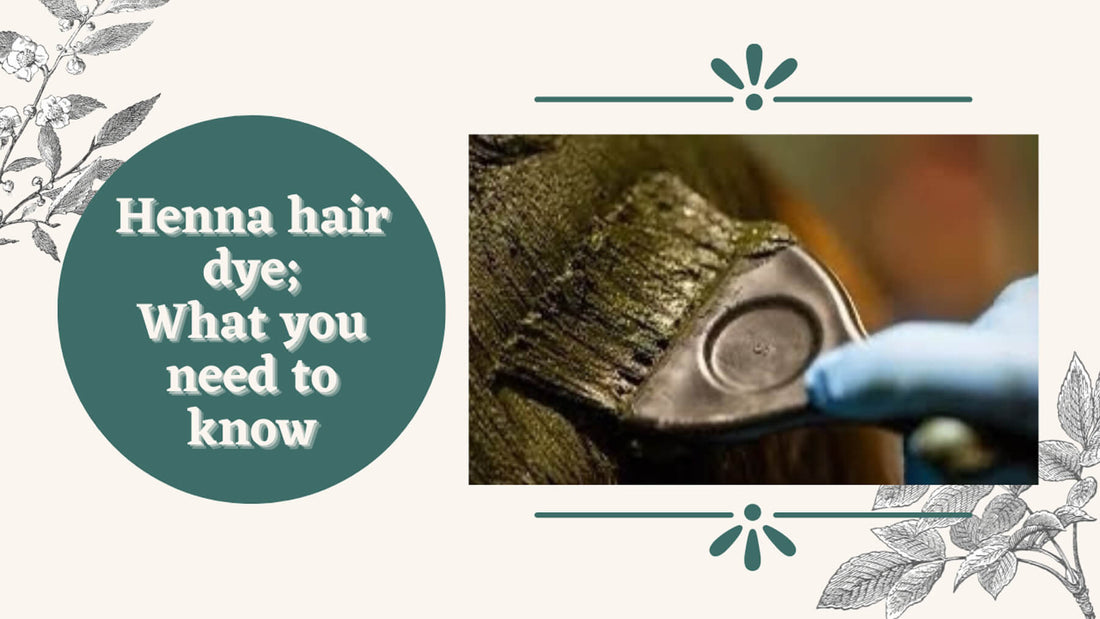Henna Hair Dye.
Is It a Good Idea or Not?
I noticed over the last few months whilst online shopping on for eco-friendly options, they have been heavily advertising henna hair dyes as an easy “natural at home alternative” to get you through lockdown.
After reading the threads on numerous community pages I felt as a hairdresser with years of experience, I needed to write this to educate people properly before they embark on this hairy journey.
Henna is a commitment and a lifestyle.
It remains in the hair until it grows out or gets chopped off. If you make the choice to use henna you should know you are in for the long haul.
And hey, you may love it and embrace the permanence but if not, there can be some serious consequences if you decide you want a change.
First things first, what is henna hair dye? Henna is a permanent hair dye derived from the Lawsonia Inermis Shrub.

Henna has been used for centuries in many cultures for hair dye and for traditional tattoo art.
100% Natural henna only comes in a reddish brown tone and it’s intensity depends on your natural hair colour and quality of your hair.
You can only deposit colour which means Henna will not lighten your hair, it will only add the red/orange reflect to your existing natural hair colour and level.
The problems with Henna mainly arise when manufactures claim they have a huge colour range of henna dyes. Some companies do use other plant extracts like indigo which you need to mix in separately to create different colours other then the reddish brown.
However this is very rare as it is a costly process. So usually they add other chemicals such as silver, copper and lead to create different colour variations.
This type of pre-mixed henna is called compound henna.
They also add chemicals like metallic salts which aid in producing the colour, when the salts react with the sulfur in the hair the dyes then bind to the hair over a period of time.
Metallic salts are also used in some box dyes which is why hairdressers are not fans of them either.
The real issue with Metallic Salts is after you have coloured your hair with compound henna, the metallic salts have a chemical reaction with ammonia which is found in the majority of professional salon colours and lighteners.
They usually contain small amounts to help open the cuticle and help the colour penetrate into the hair shaft which is what lightens the hair.
This chemical reaction can be catastrophic!
Myself and many other hairdressers have witnessed first hand some of the chemical reactions, the hair literally steaming, foils on the head that burn your hands to touch, and the hair actually melting and breaking off.
I have also been left with fluro green hair after trying to lighten the hair. It is not a pleasant experience for both parties involved when the client is left with extremely dry jelly-like green hair.

So if you are thinking about making a change and want to go lighter at all after doing this “natural process at home” then you must grow out or cut off any of the hair that has previously had the henna dye in it, which can take years.
Think about how much your hair grows in 4-5 weeks and then work out many months it would take to grow your colour out, that's how long you will have to wait to go lighter and have a change.
Henna also coats the hair and suffocates the cuticle making other chemical services not advised.
Henna is also a progressive dye, which means each application increases the coating on the hair and it becomes progressively darker.
Metallic henna dyes tend to fade into strange colours also. Those that contain lead fade to purple tones, the dyes that turn green as they fade contain silver, and those that contain copper fade red.
So before popping into the box dyes isle or cooking up some Henna (you actually have to heat it up by the way) to “get you through until your salon reopens" just ask yourself a few key questions such as:
- Do I want to stay darker until this all grows out and gets cut off ?
- Does it have metallic additives? (Some don't have specify it on the box either.)
- Will I want to have a change over the next few years and possibly go lighter even just by a shade or so?
- If you answered yes to any of these questions, step away from the Henna and home dyes and be patient!
We will be fixing that regrowth and using our years of colour knowledge and expertise to create a personalized colour to suit you and only you in no time!!
Author - Colleen Stanford is a part of the Creative Team at Chumba's Chapel St, Windsor Salon

COLLEEN 'THE FOUNDATION-STONE' STANFORD
The Colour Guru - Think 'Plastic Surgeon for your Hair'
Way back when Chumba Windsor was born in 2008 there was a moment... these moments makes or breaks an entire company.That moment was when a skater looking girl blew in our door looking a bit lost in Melb's.
We job reference people of course - her reference said "Colleen will be the best thing that has ever happened to your salon" - and so she is... for twelve years & counting ❤︎
She is the literally the best and the actual Rock that Chumba Windsor is built upon.
By way of Byron Bay home town of all Guru types, this cutting edge stylist can Colour your World and then some. 'Co(o)l' is a Creative Team member that leads the Chumba to push to the bleeding edge of hair in Chapel St. So by definition she is the coolest chick on the strip.
Have you got a tough Colour 'fix up' , 'save it', 'funk it' or 'change it' job? This is Your girl - just smile, nod and say 'go for it'.
If there's a better Correction Goddess out there somewhere it'd be news to us.
Just to add to her fully booked existence Co(o)l hits the road non stop around Australia with Queen B to educate and inspire other Hairdresser with her supernatural Colouring Powers.

